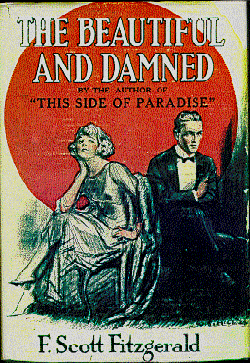The Great Gatsby Contents
Social and literary success
An established author
 In 1920 Fitzgerald at last enjoyed literary success with his first novel, This Side of Paradise. Soon afterwards followed:
In 1920 Fitzgerald at last enjoyed literary success with his first novel, This Side of Paradise. Soon afterwards followed:
- Flappers and Philosophers, his first short story collection (1920)
- a second novel The Beautiful and Damned (1922)
- more short stories in Tales of the Jazz Age (1922).
In between, several short stories were published in magazines such as The Smart Set and The Saturday Evening Post. However, his 1923 play The Vegetable was a failure. Only short-story writing kept Fitzgerald from poverty.
He reached the peak of his fame with his third novel The Great Gatsby (1925), but despite good reviews, the book didn’t sell well - there were still unsold copies from the second print run in the publisher’s warehouse when Fitzgerald died in 1940.
During his career, Fitzgerald wrote around 160 short stories and thirty articles, plus poems, plays, radio scripts and movie scripts. His fourth novel, Tender is the Night (published 1934) was met with disappointment from a number of reviewers. From 1937 he lived in Hollywood, writing movie scripts until he was dropped by Metro Goldwyn Mayer in 1938. Fitzgerald then worked on his final novel, published posthumously as an unfinished work in 1941 under the title The Last Tycoon and now known as The Love of the Last Tycoon.
Literary reputation
Following the publication of This Side of Paradise and marriage to Zelda in 1920, Fitzgerald gained a high profile in literary and high society circles. He and Zelda were notorious for drinking and engaging in wild, sometimes destructive behaviour. They mixed with artists and writers at New York parties, and when they moved to Europe, joined the expat community in Paris as celebrities.
Literary associates
 It was in the Dingo American Bar in Paris that Fitzgerald first met Ernest Hemingway, whom he had already recommended to Scribners, his own publisher, as a notable new talent. Their relationship was complex, beginning fairly positively in 1925 and becoming soured within a few years. Hemingway criticised Fitzgerald for aspects of his style and his willingness to write some fiction purely for profit. He also expressed a strong dislike of Zelda, which she reciprocated.
It was in the Dingo American Bar in Paris that Fitzgerald first met Ernest Hemingway, whom he had already recommended to Scribners, his own publisher, as a notable new talent. Their relationship was complex, beginning fairly positively in 1925 and becoming soured within a few years. Hemingway criticised Fitzgerald for aspects of his style and his willingness to write some fiction purely for profit. He also expressed a strong dislike of Zelda, which she reciprocated.
Fitzgerald also mixed with T. S. Eliot, Ezra Pound, Gertrude Stein and John Dos Passos in France. Back in America, Fitzgerald had close connections with Ring Lardner, John Peale Bishop and Edmund Wilson. Literary critics recognised him as a talented writer and an ‘author’s author’. However, this did not translate into sales of his work, and it may be that his playboy image was detrimental to Fitzgerald being taken seriously.
Increasing status
Fitzgerald’s jokey insert for the third print run of This Side of Paradise notes:
This was insightful indeed, as his work, particularly The Great Gatsby, has grown in popularity from the 1950s onwards, thanks to the attention of critics such as Edmund Wilson, Lionel Trilling and Arthur Mizener. It became more widely known via the free distribution of copies to armed services personnel during the Second World War, and is now an established subject of literary study in schools and colleges worldwide.
Financial worries
Despite the sales of his novels, Fitzgerald was never able to achieve lasting financial security based on his writing, mostly because he lived beyond his means. Like many others, he wrote commercial short stories in order to make money. He also relied on advances from his agent and editor, living in debt for much of his marriage. His money worries became more acute when Zelda’s medical bills began to arrive in the 1930s, and Fitzgerald complained that he was constrained in his creativity by the need to produce pieces to pay the bills.
